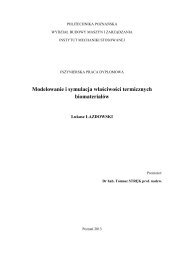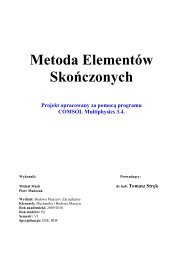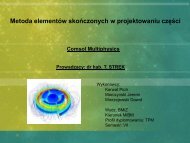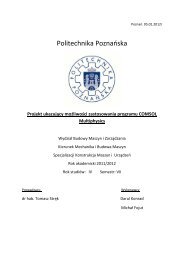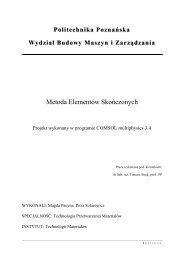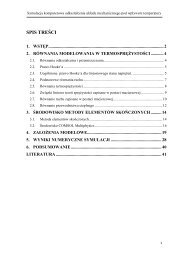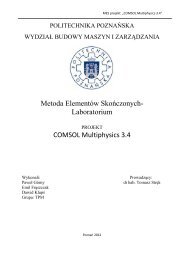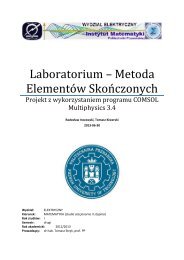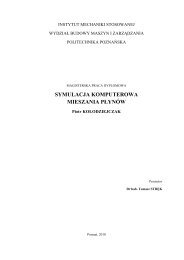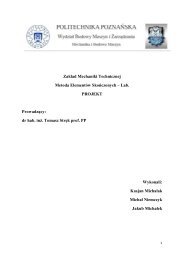COMSOL News
COMSOL News
COMSOL News
You also want an ePaper? Increase the reach of your titles
YUMPU automatically turns print PDFs into web optimized ePapers that Google loves.
MULTIPHYSICS<br />
SIEMENS CORPORATE TECHNOLOGY, MUNICH, GERMANY<br />
Modeling Optimizes a Piezoelectric Energy Harvester<br />
Used in Car Tires<br />
Siemens is using fluid-structure interaction simulation to ensure the cost-effective optimization<br />
of a cantilever in a MEMS generator designed to power a tire pressure monitoring system.<br />
BY JENNIFER HAND<br />
CO-AUTHORED BY DR. INGO KUEHNE AND DR. ALEXANDER FREY, SIEMENS AG<br />
The desire to get rid of batteries and<br />
power lines motivates a wide range<br />
of research. In the quest for systems that<br />
are energy autonomous, the concept of energy<br />
harvesting attracts much attention.<br />
Combine this idea with operation at the<br />
micro level and the ‘what if’ scenarios become<br />
even more enticing.<br />
“ Our ultimate goal is<br />
to design the MEMS<br />
generator to be as small,<br />
light and strong as<br />
possible with enough<br />
energy to power a<br />
system under a range<br />
of conditions.”<br />
For researchers at Siemens Corporate<br />
Technology in Munich, there was a strong<br />
attraction for exploring the potential of an<br />
energy harvesting MEMS (Micro Electro-<br />
Mechanical System) generator. Dr. Ingo<br />
Kuehne explains, “Our remit is broad.<br />
Figure 2. Schematic of the piezoelectric MEMS generator energy<br />
harvester. The cantilever is made of two materials and electrical<br />
energy is transferred through the circuit from the cantilever.<br />
We are looking to develop<br />
platform technologies for<br />
tomorrow rather than specific<br />
products; however,<br />
it makes sense to demonstrate<br />
the value of our research.<br />
Together with our<br />
partner Continental AG<br />
we decided to focus on an<br />
application with clear commercial<br />
potential. Our ultimate<br />
goal is to design the<br />
MEMS generator to be as<br />
small, light and strong as<br />
possible with enough energy<br />
to power a system under<br />
a range of conditions.” They chose to<br />
design a microgenerator for an innovative<br />
Tire Pressure Monitoring System (TPMS)<br />
driven by motion.<br />
Because TPMS are traditionally powered<br />
by batteries, they tend to be mounted<br />
on the wheel rim. With no reliance on a<br />
battery, such a system could be placed inside<br />
the tire and would be in a position to<br />
measure much more than pressure (Figure<br />
1). It could monitor temperature, friction,<br />
wear and torque; assist with optimal tracking<br />
and engine control; and convey all this<br />
critical information wirelessly. It would also<br />
be maintenance free, low cost and environmentally<br />
friendly.<br />
Yet, locating the device within the tire<br />
requires that the assembly be extremely<br />
robust and able to withstand gravitational<br />
acceleration up to 2,500 g. Moreover,<br />
in order to avoid tire imbalance it<br />
would have to be very light, and in terms<br />
of operational life it would need to match<br />
that of a tire, a minimum of 8 years.<br />
Figure 1. TPMS mounting options — on the rim or on the inner lining of the tire.<br />
From Mechanical Stress into<br />
Electrical Energy<br />
Mounted to one spot on the inside of a<br />
tire, a piezoelectric microgenerator would<br />
be able to harvest energy from the compression<br />
created each time that particular area<br />
of the tire touched the ground. The cantilever<br />
was designed to incorporate a thin<br />
film of self-polarized piezoelectric ceramic<br />
material with a silicon carrier layer, which<br />
provides mechanical stability and stores<br />
harvested mechanical energy (Figure 2).<br />
The team had settled on a triangular<br />
design for the spring-loaded piezoelectric<br />
cantilever, as such a shape enables a<br />
1 2 // <strong>COMSOL</strong> NEWS 2 0 1 2<br />
<strong>COMSOL</strong> <strong>News</strong> 2012-17.indd 12<br />
➮<br />
Cov ToC + – A<br />
➭<br />
5/15/12 2:59 PM



